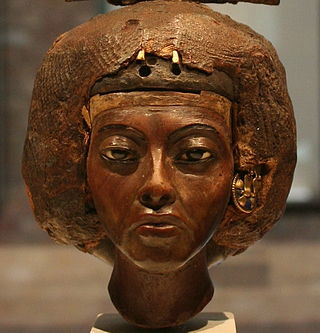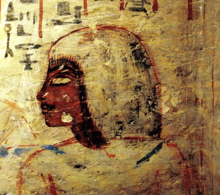
Tutankhamun or Tutankhamen, was an ancient Egyptian pharaoh who ruled c. 1332 – 1323 BC during the late Eighteenth Dynasty of ancient Egypt. Born Tutankhaten, he was likely a son of Akhenaten, thought to be the KV55 mummy. His mother was identified through DNA testing as The Younger Lady buried in KV35; she was a full sister of her husband.

Akhenaten, also spelled Akhenaton or Echnaton, was an ancient Egyptian pharaoh reigning c. 1353–1336 or 1351–1334 BC, the tenth ruler of the Eighteenth Dynasty. Before the fifth year of his reign, he was known as Amenhotep IV.

Nefertiti was a queen of the 18th Dynasty of Ancient Egypt, the great royal wife of Pharaoh Akhenaten. Nefertiti and her husband were known for their radical overhaul of state religious policy, in which they promoted the earliest known form of monotheism, Atenism, centered on the sun disc and its direct connection to the royal household. With her husband, she reigned at what was arguably the wealthiest period of ancient Egyptian history. After her husband's death, some scholars believe that Nefertiti ruled briefly as the female king known by the throne name, Neferneferuaten and before the ascension of Tutankhamun, although this identification is a matter of ongoing debate. If Nefertiti did rule as Pharaoh, her reign was marked by the fall of Amarna and relocation of the capital back to the traditional city of Thebes.

Tiye was the Great Royal Wife of the Egyptian pharaoh Amenhotep III, mother of pharaoh Akhenaten and grandmother of pharaoh Tutankhamun; her parents were Yuya and Thuya. In 2010, DNA analysis confirmed her as the mummy known as "The Elder Lady" found in the tomb of Amenhotep II (KV35) in 1898.

Amenhotep III, also known as Amenhotep the Magnificent or Amenhotep the Great and Hellenized as Amenophis III, was the ninth pharaoh of the Eighteenth Dynasty. According to different authors, he ruled Egypt from June 1386 to 1349 BC, or from June 1388 BC to December 1351 BC/1350 BC, after his father Thutmose IV died. Amenhotep was Thutmose's son by a minor wife, Mutemwiya.
Thutmose, also known as "The King's Favourite and Master of Works, the Sculptor Thutmose", was an Ancient Egyptian sculptor in the Amarna style. He flourished around 1350 BC, and is thought to have been the official court sculptor of the Egyptian pharaoh Akhenaten in the latter part of his reign. A German archaeological expedition digging in Akhenaten's deserted city of Akhetaten, known today as Amarna, found a ruined house and studio complex in early December 1912; the building was identified as that of Thutmose based on an ivory horse blinker found in a rubbish pit in the courtyard inscribed with his name and job title. Since it gave his occupation as "sculptor" and the building was clearly a sculpture workshop, the determination seemed logical and has proven to be accurate.

Horemheb, also spelled Horemhab or Haremhab, was the last pharaoh of the 18th Dynasty of Egypt. He ruled for at least 14 years between 1319 BC and 1292 BC. He had no relation to the preceding royal family other than by marriage to Mutnedjmet, who is thought to have been the daughter of his predecessor, Ay; he is believed to have been of common birth.

Meritaten, also spelled Merytaten, Meritaton or Meryetaten, was an ancient Egyptian royal woman of the Eighteenth Dynasty of Egypt. Her name means "She who is beloved of Aten"; Aten being the sun-deity whom her father, Pharaoh Akhenaten, worshipped. She held several titles, performing official roles for her father and becoming the Great Royal Wife to Pharaoh Smenkhkare, who may have been a brother or son of Akhenaten. Meritaten also may have served as pharaoh in her own right under the name Ankhkheperure Neferneferuaten.

The New Kingdom, also referred to as the Egyptian Empire, was the ancient Egyptian nation between the 16th century BC and the 11th century BC. This period of ancient Egyptian history covers the Eighteenth, Nineteenth, and Twentieth Dynasties. Through radiocarbon dating, the establishment of the New Kingdom has been placed between 1570 BC and 1544 BC. The New Kingdom followed the Second Intermediate Period and was succeeded by the Third Intermediate Period. It was the most prosperous time for the Egyptian people and marked the peak of Egypt's power.
The Amarna Period was an era of Egyptian history during the later half of the Eighteenth Dynasty when the royal residence of the pharaoh and his queen was shifted to Akhetaten in what is now Amarna. It was marked by the reign of Amenhotep IV, who changed his name to Akhenaten in order to reflect the dramatic change of Egypt's polytheistic religion into one where the sun disc Aten was worshipped over all other gods. The Egyptian pantheon was restored under Akhenaten's successor, Tutankhamun.
Prince Khaemweset was the fourth son of Ramesses II and the second son by his queen Isetnofret. His contributions to Egyptian society were remembered for centuries after his death. Khaemweset has been described as "the first Egyptologist" due to his efforts in identifying and restoring historic buildings, tombs and temples.

The Ancient Egyptian noble, Ramose was Vizier under both Amenhotep III and Akhenaten. He was in office in the last decade of Amenhotep's III reign and at the beginning of the reign of the latter king. Ramose appears on jar labels found in the palace of king Amenhotep III at Malkata. Here appears also the vizier Amenhotep-Huy. Both viziers are also shown side by side in the temple of Soleb. In the New Kingdom the office of the vizier was divided in a northern vizier and a southern one. It is not entirely clear whether Ramose was the southern or northern one.

Amenhotep (Huy) was the high steward of Memphis under Amenhotep III in the Egyptian 18th Dynasty. With this title he was one of the highest officials at the royal court.

The High Priest of Ptah was sometimes referred to as "the Greatest of the Directors of Craftsmanship". This title refers to Ptah as the patron god of the craftsmen.

Isetnofret was a royal woman of Ancient Egypt and, as the Great Royal Wife of Pharaoh Merenptah, she became Isetnofret II.
Amenhotep-Huy was a Vizier of Ancient Egypt during the reign of Amenhotep III. Besides being Amenhotep III's Vizier, Amenhotep-Huy was also director of Upper and Lower Egypt and overseer of all the works of the King in Upper and Lower Egypt.

The Eighteenth Dynasty of Egypt is classified as the first dynasty of the New Kingdom of Egypt, the era in which ancient Egypt achieved the peak of its power. The Eighteenth Dynasty spanned the period from 1550/1549 to 1292 BC. This dynasty is also known as the Thutmoside Dynasty) for the four pharaohs named Thutmose.
This page list topics related to ancient Egypt.
The Tomb of Thutmose is a small, decorated rock-cut tomb in Saqqara in Egypt that dates to the time shortly after the Amarna Period. The tomb is of special importance as one of the tomb owners was the sculptor Thutmose, often presumed to be the person who made the famous Nefertiti Bust. Another of the persons buried here was a certain Kenana.
The Bubasteum or Bubasteion was a Ptolemaic and Roman temple complex dedicated to Bastet in the cliff face of the desert boundary of Saqqara. In Arabic the place is called Abwab el-Qotat.













